The Poetic Edda: A Study Guide
The Speech of the Masked One
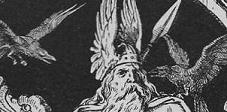
[PREVIOUS][MAIN][NEXT]
[HOME]
MS No. 2365 4to [R]
AM 748 I 4to [A]
Normalized Text:
Andhrímnir
lætr ield hrimne
Sæhrímni foðin,
fleska bezt;
en þat fáir vitu,
hvat einherjar alask.
lætr í Eldhrímni
Sæhrímni soðinn,
fleska bezt;
en þat fáir vitu,
hvat einhæria alask.
lætr í Eldhrímni
Sæhrímni soðinn,
fleska bezt;
en þat fáir vitu,
við hvat einherjar alask.
in Icelandic Poetry
“The Song of Grimnir”
The Yale Magazine, Vol. 16
“The Song of Grimner”
Andhrimner speedily returns:
The fire beneath Eldhrimner burns:
Sæhrimner smokes in floods below ---
The best reflection heroes know.
Few think how many warriors dine,
From off his wide extended chine.
These are the homes where the powerful Aser dwell,
Andhrimner from Eldhrimner bringeth forth
Saehrimner, seethed,—most excellent of meats—
And few can tell how many Einheriar feed
Thereon.
in Edda Sæmundar Hinns Frôða
“The Lay of Grimnir”
in Corpus Poeticum Boreale
“The Sayings of the Hooded One”
18. Andhrimnir makes,
in Eldhrimnir,
Sæhrimnir to boil,
of meats the best;
but few know how many
Einherjar it feeds.
in Edda Saemundar
“The Sayings of Grimnir”
in The Poetic Edda
“Grimnismol: The Ballad of Grimnir”
22. There Sooty-face boils in Sooty-flame
the boar called Sooty-black ;
'tis the best of fare, which few have heard
is the chosen warriors' food.
an attempt at restoration, but made for the sake of clearness,
is indicated by figures in parenthesis corresponding to the
strophe numbering of R
18. In Eldhrimnir Andhrimnir cooks
Sæhrimnir’s seething flesh,-
The best of food, but few men know
On what fare the warriors feast.
in The Poetic Edda
“The Lay of Grimnir”
in The Elder Edda
“The Lay of Grimnir”
18. By Andhrimnir in Eldhrimnir
Saehrimnir, the boar, is boiled,
the best of bacons; though 'tis barely known
what the einherjar eat.
18. Sooty-Face in Sooty-with-Fire,
Boils Soot-of-the-Sea:
To the Battle-slain boar's flesh
Was ever the finest fare.
in The Poetic Edda
“Grimnir’s Sayings”
in The Poetic Edda, Vol. III: Mythological Poems
“The Lay of Grimnir”
18. Andhrimnir has Sæhrimnir boiled
in Eldhrimnir,
The best of pork, but few know
By what the Einheriar are nourished.
18. Sootfree makes boil
in Sooty from the Sea,
finest of bacon,
but few men know
what the elect fighters are fed on.
2011 Andy Orchard
The Elder Edda: A Book of Viking Lore
'The Lay of Grimnir"
18. ‘Andhrimnir in Eldhímnir
has Sæhrimnir boiled;
the best of bacons, though few know
how the Einherjar are fed.
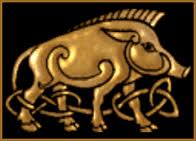
Snorri on Saehrimnir
Gylfaginning 38:
Then said Gangleri: "Thou sayest that all those men who have fallen in battle
from the beginning of the world are now come to Odin in Valhall. What has he to
give them for food? I should think that a very great host must be there." Then
Hárr answered: "That which thou sayest is true: a very mighty multitude is
there, but many more shall be, notwithstanding which it will seem all too small,
in the time when the Wolf shall come. But never is so vast a multitude in
Valhall that the flesh of that boar shall fail, which s called Sæhrímnir; he is
boiled every day and is whole at evening. But this question which thou askest
now: I think it likelier that few may be so wise as to be able to report
truthfully concerning it. His name who roasts is Andhrímnir, and the kettle is
Eldhrímnir; so it is said here:
Andhrímnir | has in Eldhrímnir
Sæhrímnir sodden,
Best of hams; | yet how few know
With what food the champions are fed."
Then said Gangleri: "Has Odin the same fare as the champions?" Hárr
answered: "That food which stands on his board he gives to two wolves
which he has, called Geri ("Ravener") and Freki ("Glutton, greedy"); but
no food does he need; wine is both food and drink to him; so it says
here:
19. Geri and Freki | the war-mighty glutteth,
The glorious God of Hosts;
But on wine alone | the weapon-glorious
Odin ever liveth.
The ravens sit on his shoulders and say into his ear all the tidings
which they see or hear; they are called thus: Huginn ("Thought") and
Muninn ("Memory"). He sends them at day-break to fly about all the
world, and they come back at undern-meal; thus he is acquainted with
many tidings. Therefore men call him Raven-God, as is said:
20. Huginn and Muninn hover each day
The wide earth over;
I fear for Huginn lest he fare not back,--
Yet watch I more for Muninn."
The Valhall Verses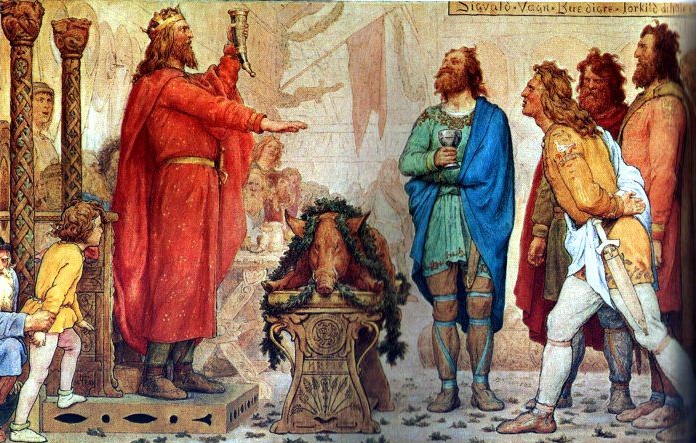
Grimnismal 18 ff. enters into a long exposition on Valhalla and the things found there. The verses are among the most cryptic in the poem, suggesting that “hidden” or “mysterious” knowledge may lie concealed here. Can the intended meaning or meanings still be teased out of the poetry? It’s worth a shot. There is relatively little commentary on this poem, and less so in English. So in many ways, we’re entering uncharted (or at least uncertain) territory.
2011 Ursula Dronke, Poetic Edda, Volume III:
“18 opens like a child’s guessing-game: if Hrímnir implies ‘covered in
soot’, Andhrímnir can mean ‘Without soot’ (cf. Vigf. s.v.
AND-) and signify the spotless Sun.
Eldhrímnir, as ‘Sooty on the Fire’ can be the soot-covered cooking-pot
on the fire of the Sun (cf. 42). Sæhrímnir is ‘best of bacon’, we are
told; it can be a black (i.e. wild) boar coming out fo the ocean to be
cooked by the Sun. The ‘black boar’ is the sooty Earth, the provider of
food. If the Boar-Earth is food for the living, what do the dead
champions sustain themselves on? How can they exist?. “I have based this
reading of 18/3-4 on the only myth I know that could relate to
Sæhrímnir. It is the Indian tale of Vishnu in his Boar Incarnation
carrying the goddess Earth up from the depths of the ocean (Zimmer 17f,
77f; PE II 115). Unfortunately, the goddess Earth is not the Boar, but
as Zimmer says (78), ‘The boar is a warm-blooded animal belonging to the
earthly sphere, yet revealing in swamps, and familiar with the watery
element. Vishnu in this form plunged into the cosmic sea…gathered into
his arms the lovely body of the still youthful Mother Earth, and while
she supported herself by clinging to his tusk, brought her up again to
the surface of the sea.’ Perhaps there has been a simplification of this
tradition leading to 18/3-4; or there is no connection at all.”
Viktor Rydberg, in Our Fathers' Godsaga, 1887, writes:
"Andhrimnir (Andhrímnir). In the poem Grímnismál, a verse reads:
“Andhrimnir in Eldhrimnir cooks Sæhrimnir, the best of meats—which
‘feeds’ the einherjes.” One can draw the conclusion that Valhall has a
cook named Andhrimnir, and that in an actual kettle named Eldhrimnir, he
cooks a real boar, Sæhrimnir, whose flesh serves as the einherjes’ food.
And for Sæhrimnir to be used for this purpose day after day, one might
further assume that it had the same quality as Thor’s goats so that,
after it was butchered, it lived again (see Snorri’s Edda). All this is
based on a misunderstanding. Into the poem Grímnismál are interpolated
verses from an old song that is thoroughly mixed with symbolic imagery;
for example describing death and sleep (Dáinn and Dvalinn) as harts in
Yggdrasil’s crown, the bridge Bifröst as a fish (since bridgeheads are
known as “fish-tails” in Icelandic), Yggdrasil with its mead-saturated
crown of leaves as a goat from whose udders the mead flows, as drink for
the einherjes, etc. Symbolic too are Andhrimnir, Eldhrimnir, and
Sæhrimnir, as N. M. Petersen in his Mythology has already observed. The
names’ common suffix –hrimnir refers to hrim (rime), “the first and
finest transformation from buoyant to solid form.” The names’ prefixes
And- Eld-, and Sæ- (Spirit-, Fire-, and Sea-) report in the clearest
manner that the skald meant the elements air, fire, and water and
thereby meant to say that only the finer elements, not the earth-matter,
are incorporated into the einherjes birth."
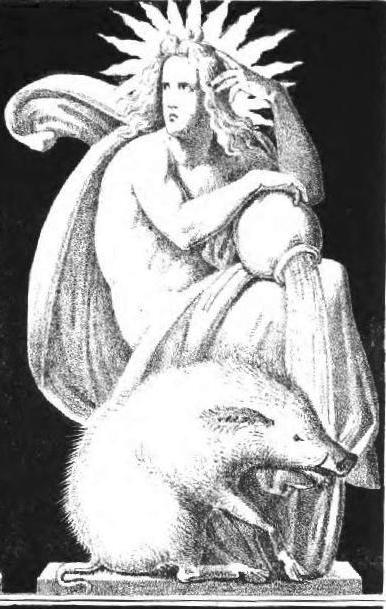
by Ameilia Schoppe 1832
Saehrimnir, the "Best Flesh"
In Grimnismál 18, we learn that the heroes of Valhalla, the
Einherjar, are fed on the meat of an ever-renewing boar, Saehrimnir. Snorri
informs us that “there will never be such a large number in Valhall that the
meat of the boar called Saehrimnir will not be sufficient for them. It is cooked
each day and whole again by evening.” (Gylfaginning 38). In Hrafnagaldur Óðins
19, the same boar is said to feed the entire company of gods. Similarly the
Einherjar drink the ever-flowing milk of the goat, Heidrun (v. 25).
In Saehrimnir, we find a parallel to Thor’s goats, which can be slaughtered and
eaten, so long as the bones are placed whole on the hide, and the heap hallowed
by Thor’s hammer. The boar, like the goats, are ever renewing sources of meat.
Saehrimnir feeds the heroes in Valhalla, who themselves are killed and come back
to life. Thus the boar is like the warriors themselves— and ever renewing supply
of “flesh”
Thor’s goats perform the same function:
Gylfaginning 44
“Öku-Thor drove forth with his he-goats and chariot, and with him that Ás called
Loki; they came at evening to a husbandman's, and there received a night's
lodging. About evening, Thor took his he-goats and slaughtered them both; after
that they were flayed and borne to the caldron. When the cooking was done, then
Thor and his companion sat down to supper. Thor invited to meat with him the
husbandman and his wife, and their children: the husbandman's son was called
Thjálfi, and the daughter Röskva. Then Thor laid the goat-hides farther away
from the fire, and said that the husbandman and his servants should cast the
bones on the goat-hides.
"Thor tarried there overnight; and in the interval before day he rose up and
clothed himself, took the hammer Mjöllnir, swung it up, and hallowed the
goat-hides; straightway the he-goats rose up…
Gylfaginning 38
Then said Gangleri: "Thou sayest that all those men who have fallen in battle
from the beginning of the world are now come to Odin in Valhall. What has he to
give them for food? I should think that a very great host must be there." …But
never is so vast a multitude in Valhall that the flesh of that boar shall fail,
which is called Sæhrímnir; he is boiled every day and is whole at evening.
When the einherjar aren’t feasting they amuse themselves by fighting. They ride
out into the courtyard every day and fight until they cut each other into
pieces. When mealtime comes they recover from their wounds and return to feast
in Valhalla.
Snorri says:
42. "A mighty band of men must be in Valhalla," said Gangler, "and methinks Odin
must be a great chieftain to command such a numerous host. But how do the heroes
pass their time when they are not drinking?"
"Every day," replied Har, "as soon as they have dressed themselves they ride out
into the court (or field), and there fight until they cut each other to pieces.
This is their pastime, but when meal-time approaches they remount their steeds
and return to drink in Valhalla. As it is said:—
'The Einherjar all
On Odin's plain
Hew daily each other,
While chosen the slain are.
From the fray they then ride,
And drink ale with the Aesir.'
The heroes like the goats regenerate. In this sense they are one. So with this
in mind, let’s look at the words of the verse:
18. Andhrímnir
lætr í Eldhrímni
Sæhrímni soðinn,
fleska bezt;
en þat fáir vitu,
við hvat einherjar alask.
Saehrimnir is called “fleska bezt,” literally the "best pork". In other Germanic dialects
“flesk”, however, refers to meat in general (“flesh”). But in Old
Icelandic, the Cleasby, Vigfusson Dictionary
defines the word “fleski” as:
FLESK (fleski, Rm. l.c.), n. [A. S. flæsc; Engl. flesh; Germ. fleisch; not in
Ulfilas; in Icelandic and all northern languages kjöt (Swed. kött, Dan.
kjöd) is the
common word, and flesk is only used of pork or bacon; Dan. flæsk; Swed. fläsk]
:-- pork, esp. ham and bacon, often used in pl.; fán fleski, Rm. 29; fleska
bezt, Gm. 18; forn fleski, Snót 226; brauð ok lítið fleski, Bs. i. 819;
galtar
flesk, Edda 23; hveiti ok flesk,
Even if limit the word “flesk” to mean only pork, we are not hindered in
understanding it as a symbolic representation of human flesh,
since all over Germania warriors are associated with boar symbols. Throughout
Anglo-Saxon art and literature, boar imagery proliferates. Boar-plates and
crests adorn several heathen era Anglo-Saxon helmets, and are described in the
poem Beowulf. In Tacitus’ Germania chapter 45, those Germanic tribes who revere
“the mother of the gods” carry her emblem, the boar, into battle to protect
themselves. In Hyndluljod, Freyja rides her lover Ottar (Oðr) in the shape of a
golden boar. Thematically, the poet connects him to Saehrimnir, in that he has
the witch Hyndla liken Freyja to Valhalla’s she-goat: “running hot at night,
like Heidrun among the he-goats” (v. 48). Heidrun is the nanny-goat which
supplies the einherjar with ever-flowing mead (cf. Thor’s he-goats which yield
an ever renewing supply of meat).
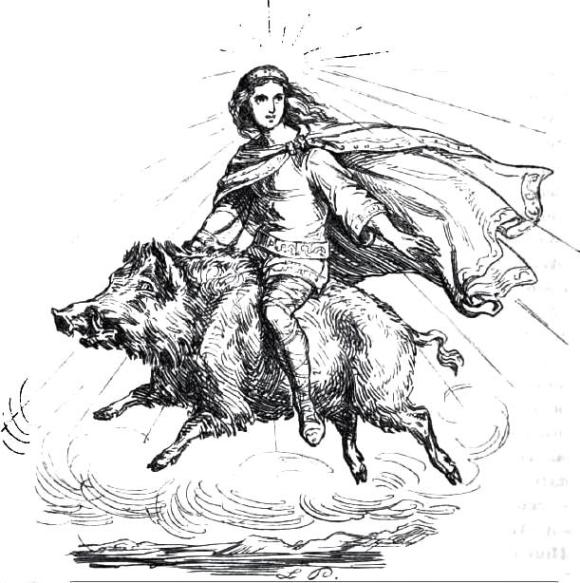
Freyja rides Hildsvini
by Luwig Pietsch 1860
The dwarves Brokk and Sindri make the golden boar Gullinbursti for Frey.
Freyja, who names her boar Hildsvini, “battle-swine”, says that he was
made for her by the dwarves Dainn and Nabbi (v. 7). Of interest here, one
interpretation of
Völuspá 10, informs us that dwarves also create the bodies of men
(manlikur). The witch Hyndla perceives
that the boar is actually her lover Ottar (Oðr) transformed, “on the way of the
slain.” (v. 6, 7, 8). Freyja herself confirms that they are on the way to
Valhalla (v. 1). Besides its usually meaning, the word “ride” also has a sexual
connotation. Riða can also refer to sexual intercourse. When Freyja's lover is
likened to a boar, it should come as no surpise that Snorri informs us that one
of Freyja’s names is Sýr, “sow”.
The boar is a symbol of virility. a main attribute of Freyja’s brother Freyr is
the boar. According to Skáldskaparmál 35, the primeval artisans Brokk and Sindri
give Freyr the golden boar called Gullinbursti or Slidrugtanni. Gullinbursti
(‘Golden Bristles’), Snorri says, can run across sea and sky by day or night
faster than any horse. Its golden bristles radiate such brilliance that it was
never dark wherever it went. According to the poem Husdrapa, Freyr, the god of
fertility, rode this boar to Baldur’s cremation. According to Voluspa, Balder
too will return from the dead, in time.
In Hyndluljod, the boar is, in fact, a transformed warrior on the way to
Valhalla ; he is Freyja’s lover and thus her ‘ride’ (a sexual pun); likewise a
boar is the food of the Einherjar (the heroes of Valhalla). So it would seem, at
the very least, we have some poetic play of words here, perhaps meant to mask a
mystery of the ancient heathen religion.
The boar symbolizes the ever renewing generations of human flesh. The “best of
meats” is human flesh. Human flesh “feeds” the einherjar. It increases their
number. In the next verse, we are told that Odin does not eat this meat, but
instead feeds it to his wolves. “Food of wolves” is a kenning for warrior, as is
“food of ravens”— animals sacred to Odin. Thus, the verse seems to suggest that
the best “pork” or “flesh”— that which feeds the Einherjar— is equivalent (if
not identical to) the ever renewing supply of warriors (i.e. human flesh), who
die in battle day after day since the beginning of time.
In Gylfaginning, Snorri says:
39. "If it be as thou hast told me," said Gangler, "that all men who have fallen
in fight since the beginning of the world are gone to Odin, in Valhalla, what
has he to give them to eat, for methinks there must be a great crowd there?"
"What thou sayest is quite true," replied Har, "the crowd there is indeed great,
but great though it be, it will still increase, and will be thought too little
when the wolf cometh.
18. Andhrímnir |
And-hrimnir |
The word alask, means “to engender”, “to beget”, “to nourish”, “to harbor”, “to rear (‘to bring up’)”. If we accept only the meaning “to nourish” we potentially lose part of the meaning.
If the boar (‘the best of meats”— “the best flesh”) is a symbol of the human being then the terms “to beget” and “to engender” make good sense in context. Dying warriors (“the food of wolves”) increase the number of the einherjar in Valhalla. They “feed” their number. They “engender/beget” more of them.
The phrase “few know what” indicates there is some esoteric knowledge hidden here. I think this touches on the very mystery of the ancient heathen religion. Warriors are symbolically equivalent to the sacrificial meat which sustains the human body and the society at large. They sacrifice their life (and like the boar are renewed, reincarnated?) for the good of the society. In Ragnarok, the einherjar join the gods to protect “those in hel”— their loved ones and family members who died and went to the underworld before them. Thus the heroes in Valhalla do what they did in life, they sacrifice themselves to protect their families and kinfolk.
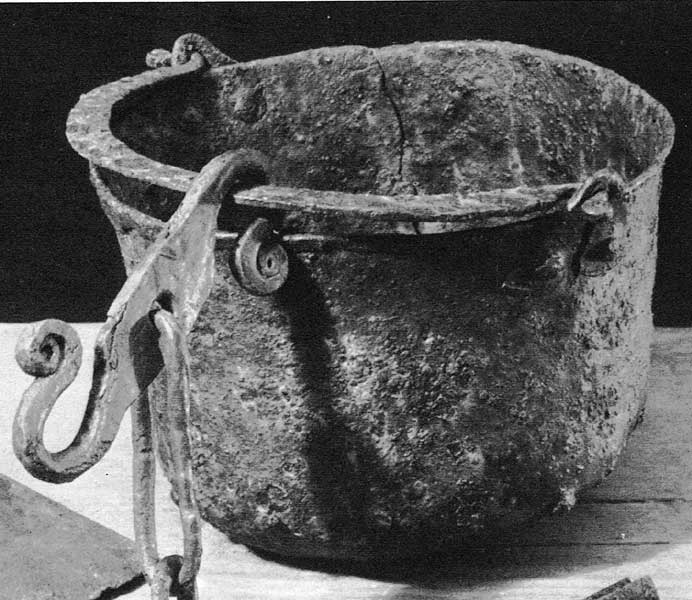
Fire, Water, Air
The verse gives three names, each with the suffix “-hrimnir.”
The Cleasby-Vigfusson Dictionary defines the word so:
HRÍM, n. [A. S. hrîm; Engl. rime; Dan. rim-frost; cp. Germ. reif]:
I. rime, hoar frost, Edda 4, Vþm. 31, Korm. (in a verse), Fms. vi. 23 (in a verse), Merl. 1. 51, freq. in mod. usage. COMPDS: hrím-drif, n. a drift of rime, Sks. 230. Hrím-faxi, a, m. Rime-mane, a mythol. horse, Edda 56, Vþm. 14. hrím-fextr, part. rime-maned, of the waves, Fas. ii. (in a verse). hrím-frosinn, part. rimy, Sks. 230. hrím-steinar, m. pl. rime stones, Edda 38, 48. Hrím-þursar, m. pl. 'Rime-giants;' the Titans of the Scandin. mythology were so called, as opposed to and older than the common Jötnar (Giants), Vþm. 33, Hm. 109, Gm. 31, Skm. 34; hrímþursar ok bergrisar, Edda 10, 15, 25, 38.
II. the black soot on a kettle, ketil-hrím. COMPDS: Hrím-gerðr, f. name of a giantess, Hkv. Hjörv. hrím-kaldr, adj. rime cold, Vþm. 21, Ls. 49, Fm. 38. hrím-kalkr, m. a rimy cup, from the froth on the mead, Ls. 53, Skm. 37.
Take your pick. Both definitions are acceptable.
In Old Norse thought, rime is a primeval element. It is already present in Niflheim at the time of creation. Snorri tells us that it flows on its own accord into Ginnungagap, where it is met by sparks and floes [eld-hrimnir, ‘fire-rime?’] from the south. In the middle is a temperate zone, where life quickens into drops, and Ymir rises along with a cow called Audhumbla who nourishes him.
As the giant sleeps, from under his arm, spring a couple of giants, male and female (a sexual pair). His feet together engender a race of ogres and trolls (who are asexual). The man and maid are perhaps best explained as Mimir and his sister Bestla, Odin’s mother. The cow Audhumbla licks a man from the ice, who marries the maiden and begets Odin and his brothers Hoenir and Lodur, also called Ve and Vili (Lokasenna 23). Together they slay Ymir and create the world. His death is the first sacrifice and catalyst to set the cycle in perpetual motion. Each act of sacrifice, whether for food or prosperity, mimiced the first and sustained the life of the creation. Scholar Bruce Lincoln affirms this as an Indo-European motif.
The prefixes mean:
And- = spirit/breath
Eld- = fire
Sæ- = sea
ANDA, að, [Ulfilas has us-anan = …Lat. animus, anima, spirit, breath: the Germans say geist, spirit, and athmen, spirare: Hellenic spiritus by gêst and athom, whence Germ. athmen: cp. Swed. ånd, ånde, spiritus, spirare.]
See sub voce önd—
ÖND, f., gen. andar, dat. öndu, and abbreviated önd; pl. andir; [önd and andi (p. 20) are twin words, for the origin see anda, to which add the Scot. aind or aynd] :-- the breath; önd gaf Óðinn, Völuspá 18.; en er barnit skaut upp öndu, Ó.H. 122; var þá niðri öndin (no sign of breathing), síðan skaut hón upp öndinni, began to draw breath, to live.
I. act. to breathe, and of the wind, to waft; …andaðr, dead; hón var þá onduð, had breathed her last, Ld. 16; …hann tók aldri til andar, ii. 225; draga öndina, to draw breath, ísl. ii. 413; …varpa mædiliga öndinni, to draw a deep breath, Orkn. 140;
2. breath, life; öndin blaktir á skari, blaktir önd í brjósti, the breath (life) flutters in the breast… hverrar lifandi andar, every living soul, Stj.; at eigi saurgisk andir yðrar, 317; andar gustr, a gush of breath, 17: týna öndu, to lose breath, die, Hkv. Hjörv. 37, Skv. 3. 58; …þá menn er sjálfir spilla öndu sinni, to spill one's breath, commit suicide, N.G.L. i. 13.
3. eccl. the soul; aldri hafði önd mín tvá líkami, Fms. iv. 121;… andar-dauði, spiritual death, Greg. 42; andar-dauðr, spiritually dead, … andar-sýn, soul's sight, a vision, Karl. 553, Bs. ii. 11; andar-gjöf, a spiritual gift, id.; andar-kraptr, 153; andar-sár, mental wounds,…. andar-vana, adj. lifeless, breathless, = andvana.
Eld- simply means “fire” and Sæ- means “sea”
Three things are named. There are three creating gods (the sons of Borr). Similarly we have three roots and three wells that feed Yggdrassil, a symbol of all creation which is also a symbol of the human body. Man himself was made from trees. In Voluspa, Yggdrassil is said to be an Ash (askur, the phrase Yggdrassils askur is also the most common designation of the world-tree). The first man is named Ash (Askr) too in the same poem. Clearly there is a conceptual connection. In kennings, the name of any tree or wooden post can be used as the basis for a warrior kenning. Humans were created from trees, and humans and trees are metaphorical equivalents.
“Spirit/breath”-hrimnir in Fire-hrimnir
lets boils Sea-hrimnir, the best of meats.
Few know how the einherjar are fed/begotten. "
If I were to hazard a guess, I’d say Grimnismal 18 is a riddle concerning the creation of man, mirroring the ideas behind Voluspa 17 and 18. Since humans are born in utero, I wonder if the phrase lætr soðinn “allows to become sodden” refers to the womb? The R manuscript (Codex Regius) has lætr foðin. Might this mean “allow to be born”?
The “eld” (fire) here may simply be the warmth of the mother’s body. A similar cryptic expression occurs in verse 22 of Fjolsvinsmal. When Svipdag inquires about the fruits that hang on the limbs of “Mimir’s tree” (v. 24) which is universally taken as Yggdrassil, the gatekeeper Fjolsvidr (an Odin-name) answers:
|
Út af hans aldni |
Its fruit is taken and laid upon a fire for women in labour; out then will come that which they carry inside; thus it metes out fate among men. |
If the fruit of the tree is taken as the human embyro, then it is “laid on a fire (á eld)” in the mother’s lap (her womb), until “out will come that which is inside” (the newborn baby).
The whole stanza is difficult and ambiguous. Neither the syntax nor the meaning can be established with certainty. The word kelisjúkar is difficult to explain. Bugge read this as killisjúkar, basing his reading on the Gothic word kilþei, meaning "womb". The first part of the stanza is usually interpreted as referring to a medicinal cure for women suffering from uterine problems. The fruit of the tree is burned on a fire, and the ailing women breathe in the medicinal fumes. This is, of course, possible, but doubtful, if we consider the second part of the stanza. The syntax of lines 4-5 is difficult, but the meaning is practically certain: something within is forced outside. This may be an illness, which is thus expulsed by the body, but the final line of the stanza is the main objection to such an interpretation. Why should the Tree be considered as "meting out fate among men", in a stanza describing the medicinal effect of its fruit on women in labour, or women suffering from an unspecified "womb-sickness"?
If Bugge's interpretation of kelisjúkar "womb-sick" is correct, this could be a synonym of jóðsjúkar "child-sick", i.e. "in labour". It could even be a term for "pregnant" (see below).
The word mjötuður is related to OE metod, and its meaning is undisputed: "one who metes out, force of destiny, fate". The World-Tree is named mjötviður in Völuspá 2, and here the meaning is identical.
Idunn's apples (the Aesir's remedy against old age, their life-elixir) were seen as fruits growing on the World-Tree. They contained the seed of life, and by eating them, the gods were able to renew their life-force. Rydberg suggests that these very same apples were seen as forming the embryos of human beings, their seeds of life. They were transported into the wombs of women, and there transformed into human embryos upon a creative "fire" burning inside the womb. The womb protects the unborn child (innar skýli) until the time comes for the child to be born (utar hverfa). In the light of such an interpretation, it becomes obvious why the tree is a mjötuður among men. They are literally born from it, grown upon its branches as fruit.
The idea of apples as embryos has been preserved in Chapter 2 of Völsungasaga. Here King Rerir and his wife are unable to have a child. They pray to the gods, and Frigg hears their prayer. As a result, one of Odin's valkyries is given an apple, and told to bring it to the king. Wearing the guise of a crow, she flies off, and drops the apple into the king's lap, where he is sitting on top of a grave-mound. After eating of the apple, the queen grows pregnant.
Goddesses serve mead at the gatherings in Asgard. When the giant Hrungnir visits Asgard, Freyja herself serves him mead [Thor asks “Why should Freyja be serving Hrungnir mead as though he were feasting among the Aesir”]. In Hrafnagaldur Odins 19, valkyries serve mead to the einherjar as they feast on the boar Saehrimnir:
|
Bekkjarsett |
Seated on benches |
Thus Freyja who serves mead at feasts where Saehrimnir is served is compared to the goat Heidrun (‘bright-rune’) who also gives clear mead at a feast in which Saehrimnir is served. She rides Ottar in the shape of a boar. Freyja herself is called Syr (sow). In Saxo, Book 7, they appear together again as Otharus and Syritha. There, she is held captive by a giantess and works as a goat-herd until he rescues her. In Hyndluljóð, the goddess Freyja is said to run hot among the he-goats, like Heidrun. She ‘rides’ her lover Ottar, on his way to Valhalla.

For more on this theme, see '39;39;The Symbolism of Sacrifice'
Delving into the Deep Myteries of the Germanic Religion
PREVIOUS][MAIN][NEXT]
[HOME]